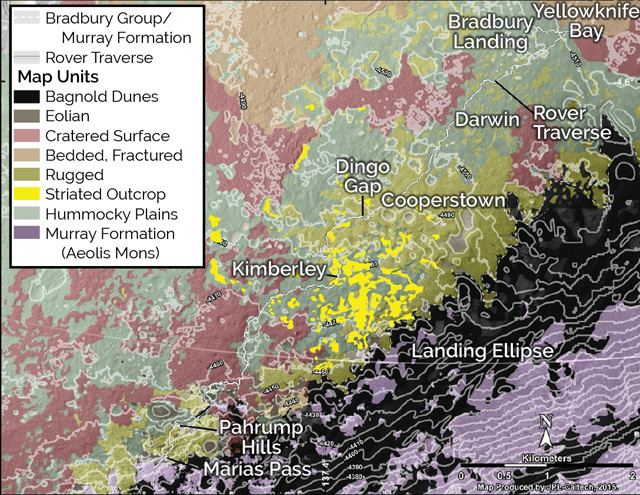
by Sarah Derouin Wednesday, February 13, 2019

The pale green regions in this map of Gale Crater geology are portions of the Hummocky Plains Unit, which contains conglomerate rock strata featuring large cross beds and ridges that researchers think were formed by glacial outburst flooding. Credit: Ezat Heydari et al., GSA Meeting, November 2018.
With two rovers and a lander on the surface of Mars, six spacecraft orbiting above it, and scientists here on Earth studying the Red Planet from afar, new findings are announced often. Here are a few of the latest updates.
Three meteorites from Mars that were found on Earth have revealed signs of organic compounds — but the compounds aren’t the result of biological activity. A team led by Andrew Steele of the Carnegie Institution for Science in Washington, D.C., dug into the abiotic processes that might have made the organics. In a study published in Science Advances, the team reported that the compounds could have formed through an electrochemical reaction triggered by the interaction of minerals and salty liquid brines on Mars. Brines can interact with volcanic rocks, essentially creating a natural battery with an anode and a cathode. It’s this reaction, the team suggests, that could power the formation of organic compounds. “The discovery that natural systems can essentially form a small corrosion-powered battery that drives electrochemical reactions between minerals and surrounding liquid has major implications for the astrobiology field,” Steele said in a statement. Such reactions could occur anywhere igneous rocks and brines coexist and interact, including some places on Earth, as well as in the subsurface oceans on Europa and Enceladus.
Roaming inside Gale Crater, the Curiosity rover has been investigating Mars’ sedimentology and stratigraphy, so far examining 400 vertical meters of strata thought to be between 3.7 billion and 4.1 billion years old. Curiosity has sent photos of these rocks back to researchers working to reconstruct the planet’s geological history. At the Geological Society of America’s (GSA) annual fall meeting last November in Indianapolis, Ezat Heydari of Jackson State University in Mississippi presented findings he and his team uncovered from their analysis of Curiosity’s photos. The team identified four different geologic units that each showed evidence of having been deposited by water. In one conglomerate unit called the Hummocky Plains Unit, for example, were rounded cobbles, 4-meter-high cross beds and asymmetric ridges. The researchers concluded that these cross beds and cobbles had been deposited by a large flowing river at least 10 to 20 meters deep. At the GSA meeting, Heydari said that the asymmetric ridges reminded him of the Channelized Scablands in Washington state. The researchers believe the Martian landforms, like the scablands, resulted from glacial outburst flooding. The researchers suggested that early Mars could have had an environment similar to that found on Earth during the Pleistocene. “On both planets, one hemisphere was covered by ice … and the other was warm,” Heydari said in a statement. Identifying these climatic similarities is important because of the implication that Mars, during the Noachian, featured liquid water that could have supported life.
Scientists have created a soundtrack for the 5,000th Martian sunrise, which was captured by the plucky Opportunity rover. Researchers scanned a picture of the sunrise from left to right, assigning each pixel a pitch and melody based on color information, brightness and terrain elevation in the picture. The dark background in the image resulted in slow quiet harmonies, while higher pitched tones were created by the bright sun in the middle. Domenico Vicinanza from Anglia Ruskin University and Genevieve Williams from the University of Exeter, both in England, presented the musical piece at the Supercomputing SC18 Conference in Dallas last November, where they used both conventional speakers and vibrational transducers to allow the audience to hear the music and feel vibrations. “Image sonification is a really flexible technique to explore science and it can be used in several domains, from studying certain characteristics of planet surfaces and atmospheres to analyzing weather changes or detecting volcanic eruptions,” Vicinanza said in a statement.
© 2008-2021. All rights reserved. Any copying, redistribution or retransmission of any of the contents of this service without the expressed written permission of the American Geosciences Institute is expressly prohibited. Click here for all copyright requests.